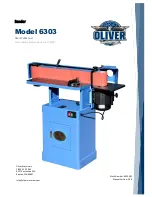
13
operations . The dust mask or respirator must be
capable of fi ltrating particles generated by your
operation. Prolonged exposure to high intensity
noise may cause hearing loss.
i) Keep bystanders a safe distance away from
work area. Anyone entering the work area must
wear personal protective equipment.
Fragments
of workpiece or of a broken accessory may fl y
away and cause injury beyond immediate area of
operation.
j) Hold the power tool by insulated gripping sur-
faces only, when performing an operation where
the cutting accessory may contact hidden wiring
or its own cord.
Cutting accessory contacting a
"live" wire may make exposed metal parts of the
power tool "live" and could give the operator an
electric shock.
k) Position the cord clear of the spinning acces-
sory.
If you lose control, the cord may be cut or
snagged and your hand or arm may be pulled into
the spinning accessory.
l) Never lay the power tool down until the acces-
sory has come to a complete stop.
The spinning
accessory may grab the surface and pull the
power tool out of your control.
m) Do not run the power tool while carrying it at
your side.
Accidental contact with the spinning
accessory could snag your clothing, pulling the
accessory into your body.
n) Regularly clean the power tool’s air vents.
The
motor’s fan will draw the dust inside the housing
and excessive accumulation of powdered metal
may cause electrical hazards.
o) Do not operate the power tool near fl ammable
materials.
Sparks could ignite these materials.
p) Do not use accessories that require liquid cool-
ants.
Using water or other liquid coolants may
result in electrocution or shock.
Kickback and Related Warnings
Kickback is a sudden reaction to a pinched or
snagged rotating wheel, backing pad, brush or
any other accessory. Pinching or snagging causes
rapid stalling of the rotating accessory which in turn
causes the uncontrolled power tool to be forced in
the direction opposite of the accessory’s rotation at
the point of the binding.
For example, if an abrasive wheel is snagged or
pinched by the workpiece, the edge of the wheel
that is entering into the pinch point can dig into the
surface of the material causing the wheel to climb
out or kick out. The wheel may either jump toward or
away from the operator, depending on direction of the
wheel’s movement at the point of pinching. Abrasive
wheels may also break under these conditions.
Kickback is the result of power tool misuse and/or
incorrect operating procedures or conditions and
can be avoided by taking proper precautions as given
below.
a) Maintain a fi rm grip on the power tool and po-
sition your body and arm to allow you to resist
kickback forces. Always use auxiliary handle, if
provided, for maximum control over kickback
or torque reaction during start-up.
The operator
can control torque reactions or kickback forces,
if proper precautions are taken.
b) Never place your hand near the rotating acces-
sory.
Accessory may kickback over your hand.
c) Do not position your body in the area where
power tool will move if kickback occurs.
Kick-
back will propel the tool in direction opposite to
the wheel’s movement at the point of snagging.
d) Use special care when working corners, sharp
edges etc. Avoid bouncing and snagging the ac-
cessory.
Corners, sharp edges or bouncing have
a tendency to snag the rotating accessory and
cause loss of control or kickback.
e) Do not attach a saw chain woodcarving blade or
toothed saw blade.
Such blades create frequent
kickback and loss of control.
Safety Warnings Specifi c for Sanding Operations
a) Do not use excessively oversized sanding disc
paper. Follow manufacturers recommendations,
when selecting sanding paper.
Larger sanding
paper extending beyond the sanding pad presents
a laceration hazard and may cause snagging,
tearing of the disc or kickback.
Safety Warnings Specifi c for Wire Brushing opera-
tions
a) Be aware that wire bristles are thrown by the
brush even during ordinary operation. Do not
overstress the wires by applying excessive load
to the brush.
The wire bristles can easily pen-
etrate light clothing and/or skin.
b) If the use of a guard is recommended for wire
brushing, do not allow any interference of the
wire wheel or brush with the guard.
Wire wheel
or brush may expand in diameter due to work load
and centrifugal forces.
Other safety Warnings
-
Only for AS/NZS:
The tool shall always be sup-
plied via residual current device with a rated re-
sidual current of 30 mA or less.
Summary of Contents for 490002
Page 4: ...4 4 2 4 3 4 4 4 1 1 3 1 4 1 5 1 6 3 2 3 1 3 3 1 2 3 180 1 1 1 2 n o ...
Page 5: ...7 8 5 6 4 6 5 6 6 6 1 6 3 6 2 5 3 5 2 5 1 6 7 1 7 2 8 1 8 2 ...
Page 84: ......
Page 85: ......
Page 86: ......














































